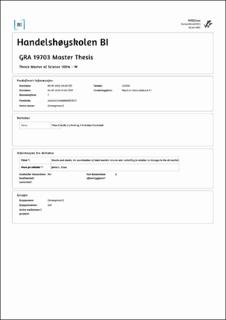| dc.description.abstract | This paper reexamines the dynamic relationship of the oil- and stock markets by
extending the original Structural vector autoregressive model (SVAR) for oil market
shocks, proposed by Kilian (2009), to include two separate measures for the stock market, returns and volatility. This facilitates a deeper dive into the distribution of the
stock market, in addition to an exploration of the relationship between stock returns
and -volatility in response to changes in the oil market. We apply our SVAR to
both U.S. and Norwegian stock price data for a further investigation of the structural
differences between oil importers and -exporters.
Using traditional zero short-run restrictions, we find that the global oil price
disruptions decomposed by Kilian (2009) are remarkably robust. Further, we
show that inclusion of several measures representing the U.S. stock price alter the
responses of the stock market dynamics. Specifically, even though returns often are
considered the preferable measure for the stock price, volatility is equally important,
and oil market disruptions are responsible for a greater part of the variability of
volatility than returns.
Next, an analysis of the Norwegian stock market dynamics unveil different responses than those of the U.S., suggesting structural differences between the two countries.
Oil market disruptions have overall greater explanatory power for the movements
of the Norwegian stock market. Concretely, we find a large part of the variability
of Norwegian returns to be caused by oil supply shocks. Conversely, oil-specific
demand shocks play a larger role for the U.S. stock market than that of Norway. We
postulate that economic structures, including net-imports of oil, and sector-focus in
the stock market, significantly affects the dynamics of the oil-stock price relationship
in a country. | en_US |
